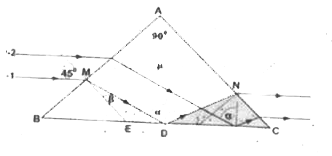Saved Bookmarks
| 1. |
ABC is an isosceles right angled triangular reflecting prism of average refractive index mu . When incident rays on face AB are parallel to face BC , then they emerges from Face AC . which are also parallel to Face BC as shown in figure-l. The prism capable to do so , known as Dove Prism. In figure-ll, the Dove Prism is used for dispersion of incident light containing red colour and violet colour only. The red colour and violet colour lights are separated( displaced ) on screen by a distance Af. In reality , each ray of any colour has some width, which can be designated as d. It is clear that an observer can distinguish the red and violet rays that emerges from prism only if Delta/varphige d .Otherwise the bundles of rays will overlap and mix. Q Find the maximum value of width d of bundle of rays that can be resolved at the outlet of Dove Prism as shown in the figure-ll. |
|
Answer» `2.25xx10^(-3)`m `/_EMD + /_ MDE = /_ BEM` `beta + (90^@ - alpha) = 45^@ implies alpha = beta+ 45^@` `implies sin(beta + 45^@)> (1/mu)` `sin beta + cos beta gtsqrt(2)/mu`…..(1) According to law of refraction at POINT M, we can write `1xxsin45^@= musn beta implies sin beta = 1/(musqrt(2)) implies cos beta= sqrt(1 - 1/(2mu^(2)))` Putting these value in equation (1), we have `1/(musqrt(2)) + sqrt(1 - 1/(2mu^(2))) > sqrt(2)/mu implies sqrt(2mu^(2) -1) > implies mu gt 1` In figure-II : Replace the Dove Prism by glass CUBE of side as AB. `Delta L =(DeltaL)/sqrt(2)` ....(2) From geometry, we can write `sin beta = 1/ (mu_(r)sqrt(2))` and `sin(beta - Deltabeta)= 1/((mu_(R) + Deltamu_(R))sqrt(2))` `Delta L = atan beta - a tan (beta- Deltabeta) = a/sqrt(2mu_(g)^(2)-1) - a/sqrt(2(mu_(R) + Deltamu)^(2) -1)` `DeltaL = a/sqrt(2mu_(R)^(2) -1 )(1- sqrt((2mu_(R)^(2)-1)/(2mu_(g)^(2) + 4mu_(R)Deltamu + 2(Deltamu)^(2) -1)))` Neglecting the value `(Deltamu)^(2)`, we have, `implies DeltaL = a/(sqrt(2mu_(R)^(2)-1)) (1 -sqrt(1/(1+ (4mu_(R)Deltamu)/(2mu_(R)^(2)-1)))) = a/sqrt(2mu_(R)^(2) -1) ( 1-{1 + (4mu_(R)Deltamu)/(2mu_(R)^(2)-1)}^(1/2))` Expand binomically, we hav `+> Delta L = (2amu_(R)Deltamu)/((2mu_(R)^(2)-1)^(3/2))` Putting this value in equation (2), we have `Deltal = (sqrt(2)amu_(R)Deltamu)/((2mu_(R)^(2)-1)^(3/2))` Second method `DeltaL = (d/(dbeta)(atanbeta))xxDeltabeta` `DeltaL=(asec^(2)beta)xxDeltabeta` Also `sin beta= 1/(sqrt(2)mu_(R))` `implies cos betaDeltabeta= 1/(sqrt(2)mu_(R)^(2)) Deltamu` `implies Delta L = (asec^(2)betaxxDeltamu)/(sqrt(mu_(R)^(2)cosbeta)` `DeltaL = (2amu_(R)Deltamu)/((2mu_(R)^(2)-1)^(3/2))` 
|
|
Discussion
No Comment Found
Related InterviewSolutions
- A wire is bent to form a semicircle of the radius a. The wire rotates about its one end with angular velocity omega . Axis of rotation is perpendicular to the plane of the semicircle . In the space , a uniform magnetic field of induction B exists along the aixs of rotation as shown in the figure . Then -
- A massless non conducting rod AB of length 2l is placed in uniform time varying magnetic field confined in a cylindrical region of radius (R gt l) as shown in the figure. The center of the rod coincides with the centre of the cylin- drical region. The rod can freely rotate in the plane of the Figure about an axis coinciding with the axis of the cylinder. Two particles, each of mass m and charge q are attached to the ends A and B of the rod. The time varying magnetic field in this cylindrical region is given by B = B_(0) [1-(t)/(2)] where B_(0) is a constant. The field is switched on at time t = 0. Consider B_(0) = 100T, l = 4 cm(q)/(m) = (4pi)/(100) C//kg. Calculate the time in which the rod will reach position CD shown in the figure for th first time. Will end A be at C or D at this instant ?
- A concave lens with equal radius of curvature both sides has a focal length of 12 cm. The refractive index of the lens is 1.5. How will the focal length of the lens change if it is immersed in the liquid of refractive index 1.8 ?
- If the tempearture of black body is raised by 5%, the heat energy radiated would increases by :
- What are the co-ordinates of the image of S formed by a plane mirror as shown in figure?
- The direction of ray of light incident on a concave mirror is shown by PQ in Fig. The direction in which the ray would travel after reflection is shown by four rays marked 1, 2, 3 and 4. Which of the four rays correctly shows the direction of reflected ray?
- What is meant by polarisation ?
- Two concentric coils each of radius equal to 2πcm are placed right angles to each other. If 3 A and 4 A are the currents flowing through the two coils respectively. The magnetic induction( in Wb m^(-2) )at the center of the coils will be
- Assertion: Out of ""_(1)He^(3) and ""_(7)He^(3), the binding energy of ""_(1)He^(3)is greater than ""_(2)He^(8). Reason: Inside the nucleus of""_(1)H^(3), there is more repulsion than inside the nucleus of ""_(2)He^(4).
- In which accelerated motion, K.E of the particle is constant